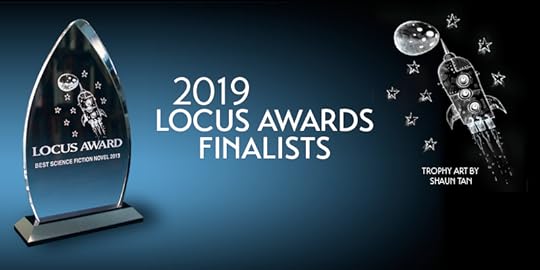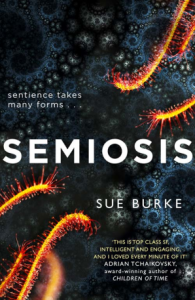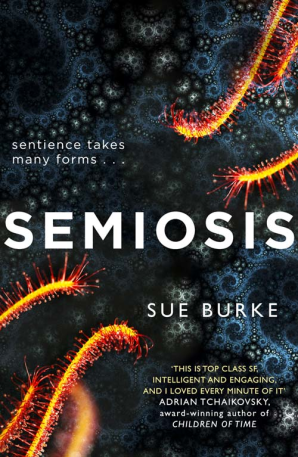Sue Burke's Blog, page 35
June 12, 2019
“Semiosis” is a finalist for the John W. Campbell Memorial Award
Finalists for this year’s John W. Campbell Memorial Award for Best Science Fiction novel have been selected, and Semiosis is on the list! I am deeply honored.
The John W. Campbell Memorial Award for Best Science Fiction Novel , or Campbell Memorial Award, is an annual award presented by the Center for the Study of Science Fiction at the University of Kansas to the author of the best science fiction novel published in English in the preceding calendar year. It is the novel counterpart of the Theodore Sturgeon Award for best short story, awarded by the same organization.
(The John W. Campbell Award for Best New Writer is a different award presented along with the Hugos at Worldcon. Yeah, I was confused at first, too.)
The Campbell Memorial Award will be presented in Lawrence, Kansas, on June 28. This year’s jury included Gregory Benford, Sheila Finch, Elizabeth Anne Hull, Paul Kincaid, McKitterick, Pamela Sargent, and Lisa Yaszek.
The full list of nominees:
• Semiosis, Sue Burke (Tor)
• A Spy in Time, Imraan Coovadia (Rare Bird)
• The Calculating Stars, Mary Robinette Kowal (Tor)
• Time Was, Ian McDonald (Tor.com Publishing)
• Blackfish City, Sam J. Miller (Ecco)
• Moon of the Crusted Snow, Waubgeshig Rice (ECW)
• Theory of Bastards, Audrey Schulman (Europa Editions)
• Unholy Land, Lavie Tidhar (Tachyon)
• Space Opera, Catherynne M. Valente (Saga)
• The Freeze-Frame Revolution, Peter Watts (Tachyon)
• The Loosening Skin, Aliya Whiteley (Unsung Stories)
June 5, 2019
My ballot for the Hugo Award Best Short Story
 I have a problem. I really like four of the six short stories nominated for this year’s Hugo Award and would be pleased if any of them won, and the other two are highly meritorious as well. If you get the chance, read these stories or any one of them chosen at random. It will be worth your time.
I have a problem. I really like four of the six short stories nominated for this year’s Hugo Award and would be pleased if any of them won, and the other two are highly meritorious as well. If you get the chance, read these stories or any one of them chosen at random. It will be worth your time.
That said, here’s my ballot. The Hugos uses a ranked voting system, so I have to rank them — but why can’t there be a co-winners like the eight finalists in the 2019 Scripps National Spelling Bee?
6. “The Court Magician,” by Sarah Pinsker (Lightspeed, January 2018)
My low rank is solely due to my disagreement over the storytelling style. A boy discovers the cost of magic, and he learns that good intentions do not overrule cold cause and effect. The fable-like telling to me felt too distant, which I thought obscured the originality of the story — that’s a quibble, though, and the ideas within the story are well worth telling.
5. “The Tale of the Three Beautiful Raptor Sisters, and the Prince Who Was Made of Meat,” by Brooke Bolander (Uncanny Magazine 23, July-August 2018)
This is a tale of dragons, a witch who is a princess, and a stupid prince, and the story is praiseworthy despite my low rank. It upends some conventions and the plot never falters. For me, it tries too hard to be funny — but a sense of humor is so uniquely personal that other people may think it strikes just the right notes.
4. “STET,” by Sarah Gailey (Fireside Magazine, October 2018)
The story format is a draft of a research paper with comments written in the margins by editors and reactions by the author. A woman loses her daughter in an accident involving an automated car and, as revealed in the research paper she writes, she believes that the car made the wrong choice. The emotions are raw, and the unusual format is used for good ends. I rated it in fourth place only because I thought the the story rested on some obvious ideas — but they’re expressed with an authenticity that lingered with me.
3. “The Secret Lives of the Nine Negro Teeth of George Washington,” by P. Djèlí Clark (Fireside Magazine, February 2018)
This won the Nebula Award, a well-deserved recognition. The story takes a fact, which is that Washington had dentures made of human teeth, and uses it to create nine short biographies of the slaves whose teeth were used, each with a unique story and a specific kind of magic. I wish the magic had changed the sweep of history somehow — but the story is satisfying without that.
2. “A Witch’s Guide to Escape: A Practical Compendium of Portal Fantasies,” by Alix E. Harrow (Apex Magazine, February 2018)
This was my vote for the Nebula Award. A witch librarian wants to help a troubled boy find the book he needs to escape his life. I liked it so much that I read it slowly so I could enjoy it longer. In truth, this is a tie for my number-one choice.
1. “The Rose MacGregor Drinking and Admiration Society,” by T. Kingfisher (Uncanny Magazine 25, November-December 2018)
I laughed out loud when I read this. Some mythical, magical men meet their match with a strong-willed mortal woman. The storytelling is wonderfully paced with delightful characterization, and it deliberately and transparently turns traditional tales on their heads. Again, humor is uniquely personal, but, personally, I loved this story.
May 29, 2019
My Goodreads review – good stories with a problem that Anderson never imagined
 The Best of Poul Anderson by Poul Anderson
The Best of Poul Anderson by Poul Anderson
My rating: 4 of 5 stars
Poul Anderson (1926–2001) won multiple awards and much acclaim during his career. His story “Eutopia” in the Dangerous Vision anthology (1967) remains one of my favorites for the way the plot hinges on the final word. This is typical of Anderson. His plots were genius.
Likewise, all nine of the stories in the collection The Best of Poul Anderson are impeccably told – and yet this book left me troubled. A quick summary of the stories might offer a clue about why.
“The Longest Voyage” (1960): Explorers (men) rather like 1700s sailors on Earth are circumnavigating their planet, and they find a high-tech artifact. Won the 1961 Hugo Award for short story.
“The Barbarian” (1956): A spoof of Conan the Barbarian.
“The Last of the Deliverers” (1958): A man arrives in a future Ohio town and debates politics in a satire of the Cold War.
“My Object All Sublime” (1961): A couple of men meet over time travel and crime – to say more would be a spoiler, and there’s a nice twist.
“Sam Hall” (1953): A man fights an oppressive government. Nominated for a Prometheus Award and Retro Hugo Award.
“Kyrie” (1968): A woman falls in love with a doomed alien. Nominated for a Nebula Award.
“The Fatal Fulfillment” (1970): A man falls afoul of a repressive system of psychological control.
“Hiding Place” (1961): A space opera story involving Nicholas Van Rijn, one of Anderson’s recurring characters.
“The Sky People” (1959): In the future on a resource-depleted Earth, a savage attack falls on a peaceful city, and a brave captain (male) saves it.
You may have noticed a certain dearth of women in significant roles. And consider the description of the only woman who is a protagonist: Her ship’s captain regards her as “gauche” and “inhibited,” and he tries to suppress his “distaste” – “but her looks! Scrawny, big-footed, big-nosed, pop eyes and stringy, dust-colored hair….”
When women are introduced in these stories, they often lead with their breasts and sex appeal: “her build left no doubt [of her mammalian life form],” “the rich black dress caressed a figure as good as any in the world,” “blond, big-eyed, and thoroughly three-dimensional,” “her gown was of shimmerite and shameless in cut,” “young and comely, and you didn’t often see that much exposed female flesh anymore,” “a stunning blonde,” “she was nice-looking … and he thought he could get her into bed.”
In “The Hiding Place,” Nicholas Van Rijn has brought a female paid sex companion on his trip whom he keeps underclad and verbally and physically mistreats. In fairness, he’s an ass to everyone, but her abuse has a rapey edge – and he’s the hero of the story. In “The Sky People,” the rescuing fleet has bare-chested woman aboard who “comfort” the men as their only means to join a exciting mission of discovery. Couldn’t they be full members of the crew and share in the adventure without prostituting themselves?
I was born in 1955. I grew up in a time when girls could only wear skirts to school – among many other arbitrary, humiliating, harmful rules, such as no competitive sports; women could legally be paid less than men for the same work if they could even get the same work; reproductive rights didn’t exist. As a headstrong girl, I chafed at the restrictions, stereotypes, and peremptory limited horizons. Reading these stories is a return to the nightmare time when I was legally a second-class citizen.
Poul Anderson can’t be held too much at fault for not seeing that, though. Second-wave feminism didn’t begin in the United States until after most of these stories were published, and progress toward equality was (and still is) slow. Other authors of that time, in and out of science fiction, were equally blind to what we can easily see now.
My question is this: What are we blind to now? What in today’s fiction will future readers point at and wonder how we could have missed something so utterly glaring?
We’re all idiots, we just don’t know what kind of idiot. Reading this book with its painful flaws ought to keep us humble.
…
(An essay with a related theme is at Tor.com: The Sad But Inevitable Trend Toward Forgotten SF.)
May 22, 2019
The Ignotus Awards 2019
[image error]The finalists have been announced for the Ignotus Awards, Spain’s equivalent of the Hugos. The categories are novel, novelette, short story, anthology, non-fiction book, article, art, audiovisual production, comic, magazine, translated novel, translated short story, and website. The winner receives a trophy in the shape of a black monolith.
I used to live in Spain, and I’m a member of the Asociación Española de Fantasía, Ciencia Ficción y Terror, which presents the awards.
Here are the nominees for best novel, which might give you an idea of what’s popular in Spain.
Bionautas [Bionauts] by Cristina Jurado
If you realized that no one on Earth is like you because your father is a bionaut, a human being who came from space, would you listen to the recording in which he tells you his story?
Neimhaim. El azor y los cuervos [Neimhaim: The Goshawk and the Crows] by Aránzazu Serrano Lorenzo
In the kingdom of Neimhaim, Jörn, son of the White Monarchs, is now 18 years old and has returned from his exile in the mountains, only to face grave challenges before fulfilling his prophecy of a great destiny.
Genesis. El libro de Phlàigh [Genesis: The Book of Phlàigh] by Juani Hernández
Kyra flees personal failure to Boston, her home town, when a mysterious man with intense blue eyes invades her dreams and holds a terrifying fate, the apocalypse itself.
Ojos verdes, negra sombra [Green Eyes, Black Shadow] by Javier Quevedo Puchal
In 1935, as Spain’s Second Republic begins to fall apart, a woman accused of a crime flees with her brother to a tiny town balanced between the past and present, magic and reality, love and hate.
Tiempo de caza [Time to Hunt] by José A. Bonilla
A business magnate is invited to join a hunting club that acts in secret at the limits of the laws of physics and the future of humanity.
May 15, 2019
What is this socket?
[image error]
I recently moved, and the wall outlets in my new apartment include two standard three-pin electrical power sockets (two power blades plus a ground pin), which are used here in the United States and in some other countries. The wall outlets also have that mysterious four-pin socket. What is it? It took me a while, but I remembered. Do you know?
I’ll give you time to think.
.
.
.
.
.
Hint: This building was constructed in 1973.
.
.
.
.
.
Another hint: Ironically, this kind of socket, installed in several places in every room as a minor luxury, almost immediately became obsolete.
.
.
.
.
.
Answer: It’s a 505A wall jack for a Bell telephone. This was where you plugged in your landline. In the 1970s, this kind of jack was replaced by the modular connector plug, which is still in use.
I graduated from high school in 1973, so I know about landlines. I remember the excitement when push-button touch-tone phones first came into use. (You could use the tones to play songs!) Still, I can’t figure out why I’d want a landline telephone now.
May 7, 2019
More news: “Semiosis” is a finalist for the Locus Best First Novel Award!
 The Locus Science Fiction Foundation has announced the finalists for its 2019 awards today. Semiosis is one of the ten finalists in the Best First Novel category.
The Locus Science Fiction Foundation has announced the finalists for its 2019 awards today. Semiosis is one of the ten finalists in the Best First Novel category.Winners will be announced during the Locus Awards Weekend in Seattle, WA, June 28 to 30. Awards are presented in sixteen catagories. Locus Magazine has covering the speculative fiction field since 1968 with news, reviews, commentary, and data. No one knows the field as well as Locus!
The full list of Best First Novel finalists — all well worth reading:
Children of Blood and Bone, Tomi Adeyemi (Henry Holt; Macmillan)
Semiosis, Sue Burke (Tor)
Armed in Her Fashion, Kate Heartfield (ChiZine)
The Poppy War, R.F. Kuang (Harper Voyager US; Harper Voyager UK)
The Quantum Magician, Derek Künsken (Solaris US; Solaris UK)
Annex, Rich Larson (Orbit US)
Severance, Ling Ma (Farrar, Straus, Giroux)
Witchmark, C.L. Polk (Tor.com Publishing)
Trail of Lightning, Rebecca Roanhorse (Saga)
Empire of Sand, Tasha Suri (Orbit US; Orbit UK)
More news: “Semiosis” is a finalist for the Locus Best First Novel Award!
 The Locus Science Fiction Foundation has announced the finalists for its 2019 awards today. Semiosis is one of the ten finalists in the Best First Novel category.
The Locus Science Fiction Foundation has announced the finalists for its 2019 awards today. Semiosis is one of the ten finalists in the Best First Novel category.
Winners will be announced during the Locus Awards Weekend in Seattle, WA, June 28 to 30. Awards are presented in sixteen catagories. Locus Magazine has covering the speculative fiction field since 1968 with news, reviews, commentary, and data. No one knows the field as well as Locus!
The full list of Best First Novel finalists — all well worth reading:
Children of Blood and Bone, Tomi Adeyemi (Henry Holt; Macmillan)
Semiosis, Sue Burke (Tor)
Armed in Her Fashion, Kate Heartfield (ChiZine)
The Poppy War, R.F. Kuang (Harper Voyager US; Harper Voyager UK)
The Quantum Magician, Derek Künsken (Solaris US; Solaris UK)
Annex, Rich Larson (Orbit US)
Severance, Ling Ma (Farrar, Straus, Giroux)
Witchmark, C.L. Polk (Tor.com Publishing)
Trail of Lightning, Rebecca Roanhorse (Saga)
Empire of Sand, Tasha Suri (Orbit US; Orbit UK)
“Semiosis” is on the Arthur C. Clarke Award shortlist!
 I am thrilled to announce that Semiosis is shortlisted for the Arthur C. Clarke Award. The shortlist was announced today, and the full list is:
I am thrilled to announce that Semiosis is shortlisted for the Arthur C. Clarke Award. The shortlist was announced today, and the full list is:Semiosis by Sue Burke (HarperVoyager)
Revenant Gun by Yoon Ha Lee (Solaris)
Frankenstein in Baghdad by Ahmed Saadawi (Oneworld)
The Electric State by Simon Stålenhag (Simon and Schuster)
Rosewater by Tade Thompson (Orbit)
The Loosening Skin by Aliya Whiteley (Unsung Stories)
These are splendid books, and I am lucky and honored to be among them.
The award describes itself as “the UK’s premier prize for science fiction literature.” The winner will be announced on July 17 in London and receives an engraved bookend and a cash prize.
“Semiosis” is on the Arthur C. Clarke Award shortlist!

The cover of the British edition. Cover design by Claire Ward. The tentacles are of a sundew, a carnivorous Earth plant that would find you much too big to be prey but otherwise delicious.
I am thrilled to announce that Semiosis is shortlisted for the Arthur C. Clarke Award. The shortlist was announced today, and the full list is:
Semiosis by Sue Burke (HarperVoyager)
Revenant Gun by Yoon Ha Lee (Solaris)
Frankenstein in Baghdad by Ahmed Saadawi (Oneworld)
The Electric State by Simon Stålenhag (Simon and Schuster)
Rosewater by Tade Thompson (Orbit)
The Loosening Skin by Aliya Whiteley (Unsung Stories)
These are splendid books, and I am lucky and honored to be among them.
The award describes itself as “the UK’s premier prize for science fiction literature.” The winner will be announced on July 17 in London and receives an engraved bookend and a cash prize.
May 1, 2019
O fortuna! Homer tells your future

I’m studying Latin — a lively language, even if it’s nobody’s native tongue. Beginning students of Spanish learn to say “¿Dónde está la biblioteca?” (Where is the library?) and “Mi casa es grande y azul” (My house is large and blue). These sentences serve mere quotidian purposes. In Latin, we learn “Otium sine litteras mors est” (Leisure without literature is death) and “Angustus animus pecuniam amat” (The shallow mind loves money). These sentences soar with ancient wisdom.
Along with grammar and vocabulary, a language learner must study culture, since language and culture interlock. So far I’ve studied Rome’s legendary founding, its customs, and a few witty observations from Horace’s satires.
Romans were very concerned about the future, and among their many fortune-telling techniques is the Homeromanteion. To use this, you must formulate your question, then roll a dice three times. The resulting number corresponds to a numbered list of lines from the verses of immortal Homer’s Illiad and Odyssey. For example:
Line 335: “He promised that the people would stay safe and not perish.”
Line 622: “Remembering our talent, such as to us.”
Line 263: “They might feast here for the last and final time.”
You can test your fortune at the online Homeromanteion, which comes complete with a virtual dice. Remember to pray to the gods so they will give you the wisdom to interpret the answer.
Vale (May you be well).
You can find more information on ancient fortune-telling at the British Library’s medieval manuscripts blog.
You can browse an archive of the Latin Word of the Day and see the word’s use in a wisdom-filed sentence at Transparent Language. From May 27: Hodie (today). Qui non est hodie cras minus aptus erit. (He who is not prepared today will be less so tomorrow.) Note the elegant juxtaposition of “hodie” and “cras” (tomorrow).



